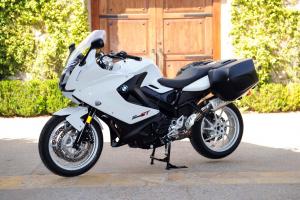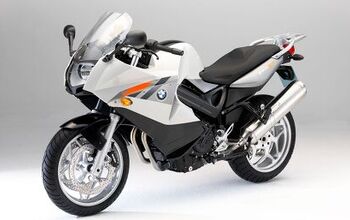2013 BMW F800GT Review - Motorcycle.com
The hallmark of a great manufacturer is the willingness to listen to its customer base. This involves more than simply fielding complaints; the ability to take criticism and incorporate suggestions into its product is what separates the icons from the also-rans.
Behold, the new BMW F800GT. Its development came about as a result of ST riders who lit up discussion forums and focus groups with demands of “more G, less S.” Simply put, the bike is faithful to the spirit of the venerable F800ST – a lightweight sport-touring canyon-carver with excellent handling – but offers a more touring-friendly approach, as well as incorporating modern technology such as anti-lock braking (ABS), automatic stability control (ASC) and optional electronic suspension adjustment (ESA) found on other current BMWs.
The result is an appropriately amenable Gran Turismo that provides comfort and confidence for days in the saddle while keeping the adrenaline pumping. Most impressive? The GT’s base MSRP of $11,890 is exactly the same as 2013’s ST. Sort of.
MORE SPORT-TOURING: 2013 Sport-Touring Shootout 1.0 - Video
The reconfigured liquid-cooled 798cc parallel-Twin increases power output by five ponies over the old ST’s mill, which cranked out nearly 80 horses at the rear wheel when tested in a shootout against Honda’s VFR800 a few years ago. To minimize vibration, it utilizes an even firing sequence, i.e., both pistons move up and down simultaneously. An unexpected, pleasant result is the sound and feel of the Twin is rather akin to that of BMW’s iconic Boxer. Combine that power with a 470-pound ready-to-ride wet weight, a dependable belt drive and a fluid 6-speed transmission, and you’ve got a ride that highlights the “sport” in sport-tourer.
The whole point of a bike of this ilk is to let its rider have fun while getting there, and because the GT leans so willingly and pulls so assuredly, it allows its rider to dive in and out of canyon corners as gamely as it lets him relax on the superslab. One can easily have two-lane touring fun one day, and then make up time on the interstate the next. Moreover, it’s surprisingly light and nimble, meaning the GT won’t fatigue a rider like its competition in the 1300cc – and 700 to 800 pound – range, such as those in our recent Sport-Touring Shootout.
How does the GT differ from its predecessor? The full fairing is the most obvious upgrade. Its lower portion not only provides better protection, but its grown-up chin also presents a more adult countenance than did the ST. The swingarm looks the same but is two inches longer than before, resulting in increased stability and a smoother ride. The alloy wheels are also new, ditching the ST’s stodgy star pattern for a forward-leaning spoke. The mirrors haven’t changed but their stems are longer, providing an excellent field of rear vision.
Instrumentation includes an analog tach and speedo set atop one another, augmented by digital LCD readouts that include a fuel gauge, odometer, dual tripmeters, clock and engine temperature. An onboard computer that displays average speed and mileage readings, range to empty, and a stopwatch/timer is an optional item.
The rubber-mounted handlebar reduces vibration and is set slightly closer to a rider and 0.8 inch higher than before, while the footpegs are 0.4 inches farther forward and the same distance lower. The standard 31.5-inch seat is 1.6 inches lower and significantly wider than was the ST’s. The slightly lipped windshield also terminates closer to the rider than did the ST’s. All this translates to a more touring-friendly ride than the ST could provide.
ROADSTER: 2011 BMW F800R Review
Speaking of two-up, thanks to the longer swingarm and redesigned rear frame, the GT boasts a 24-pound payload rating improvement over the ST. Interestingly, the front fork provides no adjustment, while the shock’s preload is adjustable using the tried-and-true hydraulic knob method, which apparently offers less resistance and therefore turns more easily than did the ST’s.
The optional ESA fine-tunes only the rear suspension – and even then, just its rebound damping. The suspension on our test bike was set up well for my average-sized body – I didn’t feel the need to adjust a thing. I toyed with the ESA on all types of terrain and found, typically, it suited me best in its Normal, not Sport or Comfort, mode.
As on all new BMWs, ABS is standard on the GT. The ASC (traction control) can be deactivated; the ABS cannot.
Listening to customer criticisms and concerns has resulted in an interesting approach to offering the F800GT in North America. A whole host of accessories is, of course, available. Not so obvious is that the aforementioned stripped GT, with its ballyhooed base-model MSRP of under 12 grand, can be had only through special order.
Instead, dealerships in North America will receive shipments of the GT outfitted with accessory packages in line with what the majority of its customers desire, according to BMW. The Standard Package ($12,395) features BMW’s “Comfort Package” – heated grips, side bag mounts, centerstand, and onboard computer. The Premium Package ($13,190) features all those accoutrements plus BMW’s “Safety Package,” which includes ESA, ASC, and digital tire pressure monitor.
But there are perks to the options. For example, riders of the outmoded ST who desired an optional Low seat were required to also purchase the Low front suspension. Not so with the new GT. Also, the GT’s Low seat comes at zero cost to the consumer; the optional 32.3-inch-high Comfort Seat, with its wider pan and extra padding, runs $145.
Other optional accessories include BMW Motorrad’s Navigator IV GPS, top case, tank bag, hard black side bags (as pictured), luggage liners and a tinted windscreen.
All told, the F800GT occupies a particular place in the sport-touring segment. It’s lightweight and nimble enough to be approachable for most any rider, and its strong power-to-weight ratio gives it respectable entertainment value. And its MSRP is within the manageable range for a sport-touring rig – particularly considering the storied roundel that graces its fairing.
Any motorcyclist who’s thought about putting a sport-touring bike in his or her stable but is leery of the size and price of one of the more typical models would do well to have a look at the new Beemer.
LAST-GEN: 2008 Middleweight Sport-Touring Shootout: BMW F800ST vs. Honda VFR800 Interceptor
More by Jon Langston




































Comments
Join the conversation